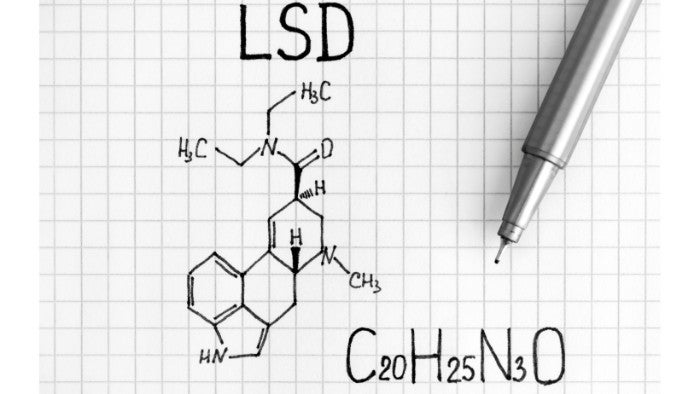

Medically reviewed by Giordano Novak, University of São Paulo on April 3rd 2022
So, you’re thinking about trying LSD? Well, it can be an incredible drug that has been known to change lives and bring out the best in people.
At the same time, there is always the risk of a bad trip, and unpredictability is the major downside to psychedelics.
LSD is made from lysergic acid, and it is found in ergot fungus on rye and other grains. However, it cannot be taken raw and instead needs to be synthesized in a lab to make acid. As a result, it is classed as a semisynthetic drug.
In this article, I’m going to take you through everything you need to know about what acid is, what it’s made from, and the way in which it works. That way, you’ll be a little more informed before you decide to head out on your first trip.
LSD (lysergic acid diethylamide) is a psychedelic DRUG that Albert Hoffman first synthesized in 1938. It produces CHANGES in perception and thought processes, resulting in feelings of euphoria.
LSD works by binding to serotonin receptors in the BRAIN. This interaction alters the levels of neurotransmitters like serotonin, dopamine, and glutamate, which can lead to CHANGES in mood and behavior [1].
The effects of LSD are felt within half an hour of ingestion and typically last 8-12 hours. During this time, users experience INTENSE visual and auditory hallucinations and distortions.

Pro Tip: Acid is not an addictive drug and cannot cause physical dependence or physical withdrawal symptoms. However, you can build a tolerance to LSD that could lead to drug abuse and psychological dependence.
LSD is made from lysergic acid, which is found in ergot fungus on rye and OTHER grains. It has to be synthesized in a lab to turn it into acid [2]. The process of synthesizing LSD is complex and involves several steps.
These steps are as follows:
Pro Tip: LSD is usually liquid and has a slightly bitter taste. The consistency is similar to sugar cubes as it dissolves in the mouth.
LSD generally produces effects that can be divided into TWO categories: physical and psychological. Physically, it can cause dilated pupils, INCREASED body temperature, sweating, loss of appetite, sleeplessness, and tremors.
Psychologically speaking, users may experience a RANGE of emotions, such as euphoria and introspection, as well as psychedelic visual effects, like the ALTERED perception of time and space [3].
However, there is always the RISK of a bad trip, which is an unpleasant experience. This tends to be characterized by FEELINGS of fear, anxiety and paranoia.
Pro Tip: There is potential for LSD to be used to treat severe depression, although a lot more research is needed.
Additionally, those with mental health problems may find that LSD exacerbates their symptoms, and those should NEVER take it with a history of psychosis.
This is because it can lead to an increased risk of HPPD (hallucinogen-persisting perception disorder), a form of psychosis that can last for months or YEARS after taking LSD [4].
LSD comes in VARIOUS forms, including tablets, capsules, microdots, liquid and blotter paper. The way in which these differ is based on their PURITY and the dose.
For example, blotter paper is typically the most diluted form of LSD, with each square containing between 20 and 80 micrograms. This is in CONTRAST to liquid acid, which can contain up to 500 micrograms per drop.
Pro Tip: Acid might not be addictive, but there is LSD addiction treatment available for those who are struggling with drug use and need help with acid or other illicit drugs.
If you’re looking to buy some LSD, the GOOD news is that you can get it online. We have a trusted seller that we recommend to all of our readers so that you can ensure you get a PURE supply that is safe to use.
They have A great reputation, which means you know you’re getting the good stuff.
The reason this is important is that there are dealers out there who LACE their supply with filler ingredients to CUT costs and boost profits.
These ingredients can have harmful effects on your health and even cause poisoning. All we want is for you to be SAFE during your LSD trip.
LSD is a powerful hallucinogenic drug that has been around for decades. It can produce INTENSE psychological and physical effects but also comes with the RISK of a bad LSD trip or even HPPD if taken in EXCESS or by those with mental health issues.
It’s important to buy your LSD from a trusted seller online to ensure that you’re getting the real deal and not something laced with DANGEROUS ingredients.
We hope this article has been helpful in educating you about LSD and its effects, as well as the POTENTIAL risks associated with it.
1: Liechti ME. Modern Clinical Research on LSD. Neuropsychopharmacology. 2017;42(11):2114-2127. doi:10.1038/npp.2017.86
2: LSD – Alcohol and Drug Foundation. Adf.org.au. Published 2023. Accessed January 10, 2023. https://adf.org.au/drug-facts/lsd/
3: Fuentes JJ, Fonseca F, Elices M, Farré M, Torrens M. Therapeutic Use of LSD in Psychiatry: A Systematic Review of Randomized-Controlled Clinical Trials. Frontiers in Psychiatry. 2020;10. doi:10.3389/fpsyt.2019.00943
4: Hermle L, Simon M, Ruchsow M, Geppert M. Hallucinogen-persisting perception disorder. Therapeutic Advances in Psychopharmacology. 2012;2(5):199-205. doi:10.1177/2045125312451270
5: LSD Used As Analgesic. (1964, January 4). JAMA | JAMA Network. Available at: https://jamanetwork.com/journals/jama/article-abstract/1161566
Subscribe and get $15 off your next order!
PRISMS LSD CANADA
Please note we have a new etransfer email. Please follow the details at checkout.
Dismiss